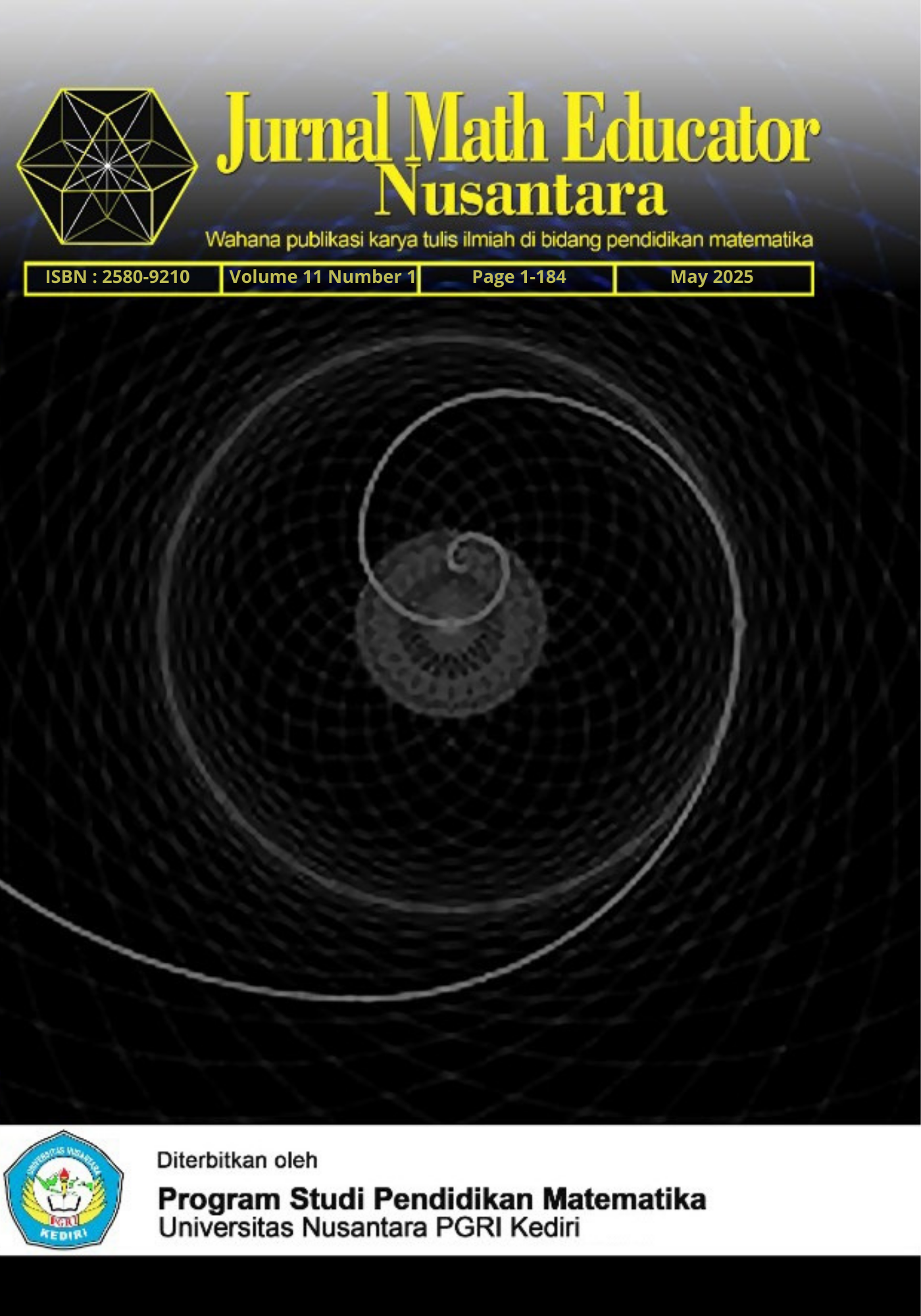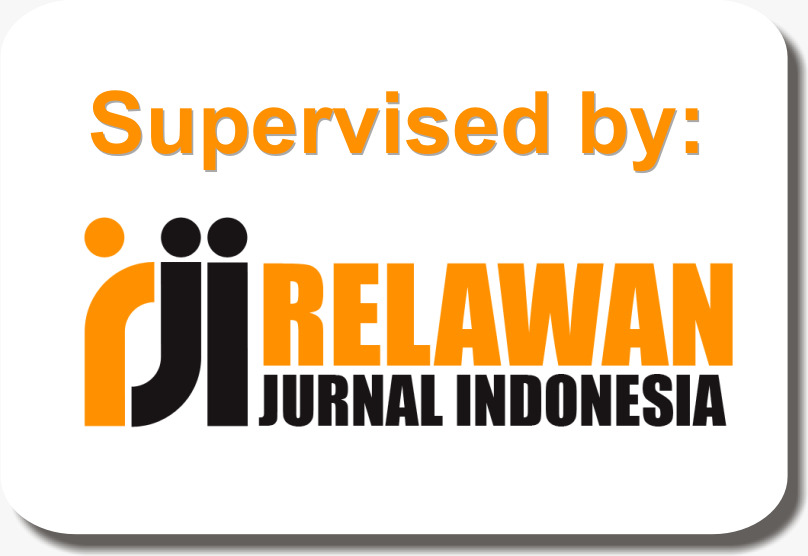The effectiveness of drill method based cognitive domain on concept understanding and problem solving abilities of calculus
DOI:
https://doi.org/10.29407/jmen.v11i1.25019Keywords:
drill method, concept understanding, problem solving abilitiesAbstract
The aim of this research was determined the effectiveness of drill method based cognitive domain on concept understanding and determined the effectiveness of drill method based cognitive domain on problem solving abilities in calculus. The research method used quantitative with an experimental method with one group pretest-posttest design. Sampling technique used purposive sampling. Data analysis technique used paired sample t-test and then followed by N-Gain analysis which is calculated using SPSS v.26 for Windows program. Results of paired sample t-test from concept understanding data showed significant value (Sig.=0,000) of less than 0,05 so was rejected, meaning that there was an influence of using drill method based cognitive domain on concept understanding. Results of N-Gain test showed that average of N-Gain percentage was 56,73%, meaning that drill method based cognitive domain on concept understanding was quite effective. Results of paired sample t-test from problem solving abilities data showed significant value (Sig.=0,000) of less than 0,05, so was rejected, meaning that there was an influence of using drill method based cognitive domain on problem solving abilities. Results of N-Gain test showed that average of N-Gain percentage was 56,61%, meaning that drill method based cognitive domain problem solving abilities was quite effective. Conclusion of this research was the effectiveness of drill method based cognitive domain on concept understanding and problem solving abilities in calculus is quite effective.
References
Adawiyah, R. (2022). Kemampuan Berpikir Kreatif Mahasiswa Semester Awal Melalui Penggunaan Bahan Ajar Berbasis HOTS. Linear: Jurnal Ilmu Pendidikan, 6(2), 65–74. https://doi.org/10.53090/jlinear.v6i2.356
Anggraeni, F. (2024). METODE DRILL BERLEVEL BERBASIS TEAMS GAMES TOURNAMENT UNTUK MENINGKATKAN PEMAHAMAN MATEMATIS. Euclid, 11(1), 17–32.
Azzahro, D. F., Salsabila, H. I., & Fitri, Y. N. (2022). Studi Literatur: Model Pembelajaran PBL dan Metode Drill untuk Meningkatkan Kemampuan Pemecahan Masalah Matematis Siswa. Prosiding Seminar Nasional Pendidikan Matematika, IV(Sandika IV), 163–176. https://proceeding.unikal.ac.id/index.php/sandika/article/view/1188
Brookhart, S. M. (2016). How to use grading to improve learning. ASCD.
Febriyani, A., Hakim, A. R., & Nadun, N. (2022). Peran Disposisi Matematis terhadap Kemampuan Pemahaman Konsep Matematika. Plusminus: Jurnal Pendidikan Matematika, 2(1), 87–100. https://doi.org/10.31980/plusminus.v2i1.1087
Haryati, T. (2021). Peningkatan Hasil Belajar Siswa Dengan Menggunakan Metode Pembelajaran Active Learning Tipe Quiz Team Pada Mata Pelajaran Ilmu Pengetahuan Alam di MTsN Kuranji Padang. EEJ: Ekasakti Educational Journal, 1(2), 330–341. https://doi.org/10.31933/eej.v1i2.874
Larson, R. (2012). Calculus: an applied approach. Cengage Learning.
Magdalena, I., Hidayah, A., & Safitri, T. (2021). Analisis Kemampuan Peserta Didik Pada Ranah Kognitif, Afektif, Psikomotorik Siswa Kelas II B SDN Kunciran 5 Tanggerang. Jurnal Pendidikan Dan Ilmu Sosial, 3(1), 48–62. https://doi.org/10.36088/nusantara.v3i1.1167
Mardatillah, A., Nurhaswinda, S., Fadhilaturrahmi, & Kusuma, Y. Y. (2023). Penerapan Model Pembelajaran Drill untuk Meningkatkan Pemahaman Konsep Siswa pada Mata Pelajaran Matematika di Sekolah Dasar. JPM: Jurnal Pendidikan MIPA, 13(4), 1126–1131. https://doi.org/10.37630/jpm.v13i4.1318
Muttaqin, A., K, Y., Y, & Irmayanti. (2023). Pemanfaatan Aplikasi Math Way Dalam Menyelesaikan Soal Kalkulus Pada Mahasiswa Tadris Matematika. Prosiding SENTIKJAR, 2, 63–70. https://doi.org/10.47435/sentikjar.v2i0.1829
Nasir, A. M. (2016). Statistik Pendidikan. Media Akademi.
Nursyeli, F., & Puspitasari, N. (2021). Studi Etnomatematika pada Candi Cangkuang Leles Garut Jawa Barat. Plusminus: Jurnal Pendidikan Matematika, 1(2), 327–338. https://doi.org/10.31980/plusminus.v1i2.905
Purcell, E. J. (2011). Kalkulus. Jilid 2 edisi IX. Erlangga.
Rahman, A. (2020). Pengaruh metode drill terhadap hasil belajar matematika siswa sekolah dasar. Jurnal Pendidikan Dasar Nusantara, 5(2), 145–152.
Retnawati, H. (2017). Pengembangan tes kemampuan berpikir tingkat tinggi. Jurnal Penelitian dan Evaluasi Pendidikan, 21(1), 1–12. https://doi.org/10.21831/pep.v21i1.13065
Sanjaya, W. (2016). Strategi pembelajaran berorientasi standar proses pendidikan. Kencana.
Sari, A. A. P., & Buchori, A. (2024). Penerapan Model Problem Based Learning Untuk Meningkatkan Kemampuan Pemecahan Masalah Matematis Siswa SMA Pada Materi SPLTV. SUPERMAT Jurnal Pendidikan Matematika, 8(1), 38–43. https://doi.org/10.33627/sm.v8i1.1904
Sari, D. P., & Sari, N. (2021). Pengaruh Metode Demonstrasi dan Metode Drill Terhadap Hasil Belajar Matematika Di SD Cenderawasih 2 Jakarta. STATMAT: Jurnal Statistika dan Matematika, 3(1), 12–18. https://doi.org/10.32493/sm.v3i1.7788
Sari, R. D., & Rakhmawati, F. (2023). Pengaruh Metode Drill Berbantuan Buku Saku Matematika Berbasis HOTS Terhadap Hasil Belajar Siswa Pada Kelas X. Jurnal Cendekia: Jurnal Pendidikan Matematika, 7(2), 1284–1294. https://doi.org/10.31004/cendekia.v7i2.2259
Siswanto, E., & Meliasari. (2024). Kemampuan Pemecahan Masalah Pada Pembelajaran Matematika: Systemic Literature Review. Jurnal Riset Pembelajaran Matematika Sekolah, 8(1), 45–58. https://doi.org/10.21009/jrpms.081.06
Suardiana, I. M. (2021). Metode Drill untuk Meningkatkan Hasil Belajar Matematika pada Siswa Kelas IV SD. Journal of Education Action Research, 5(4), 542-547. https://doi.org/ttps://doi.org/10.23887/jear.v5i4.39476
Subekti, H. (2018). Pengaruh metode latihan terhadap keterampilan dasar siswa. Jurnal Ilmu Pendidikan, 3(1), 34–40.
Sugiyono. (2015). Metode Penelitian Pendidikan Pendekatan Kuantitatif, Kualitatif, dan R&D. Alfabeta.
Susilo, B. E., Darhim, D., & Prabawanto, S. (2021). Students' learning difficulties in integral calculus based on critical thinking skills. Journal of Physics: Conference Series, 1918(4), 042058. https://doi.org/10.1088/1742-6596/1918/4/042058
Tussakynah, W., Sormin, M. A., & Samosir, B. S. (2024). Pengaruh Pembelajaran Drill and Practice Terhadap Kemampuan Pemecahan Masalah Matematis Siswa. Jurnal Pendidik Indonesia, 5(2), 66–71. https://doi.org/10.61291/jpi.v5i2.53
Wahyuni, R. (2023). Pengaruh Positif Penggunaan Metode Drill Dalam Pembelajaran Matematika. Skylandsea Profesional Jurnal Ekonomi, Bisnis, dan Teknologi, 3(1), 100–103. https://jurnal.yappsu.org/index.php/skylandsea/article/view/138
Wulansari, K. T., Rohana, & Marhamah. (2022). Metakognisi Dalam Pemecahan Masalah Matematika Pada Siswa Kelas VIII SMP. Mathema Journal, 4(2), 107–117. https://doi.org/10.33365/jm.v4i2.2124
Downloads
Published
Issue
Section
License
Copyright (c) 2025 Fajar Lestari, Muhamad Safa’udin

This work is licensed under a Creative Commons Attribution 4.0 International License.
Authors who publish with this journal agree to the following terms:
- Copyright on any article is retained by the author(s).
- The author grants the journal, the right of first publication with the work simultaneously licensed under a Creative Commons Attribution License that allows others to share the work with an acknowledgment of the work’s authorship and initial publication in this journal.
- Authors are able to enter into separate, additional contractual arrangements for the non-exclusive distribution of the journal’s published version of the work (e.g., post it to an institutional repository or publish it in a book), with an acknowledgment of its initial publication in this journal.
- Authors are permitted and encouraged to post their work online (e.g., in institutional repositories or on their website) prior to and during the submission process, as it can lead to productive exchanges, as well as earlier and greater citation of published work.
- The article and any associated published material is distributed under the Creative Commons Attribution-ShareAlike 4.0 International License
















